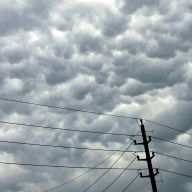As we enjoyed the first official week of summer, in many parts of Canada it finally felt like summer. Around here, it certainly smelled like summer down by the lake. Trillions of small green cells began washing ashore and rotting.
Actually, to focus on the smell is a bit like having your car stolen and bemoaning the loss of your pine-tree air freshener. The blooms can cause more serious problems than the shoreline smelling. This large slug of biomass, whatever does not wash ashore, will eventually sink and rot there, removing oxygen from the deeper water. In extreme cases, this can cause fish kills. If you thought the algae stunk up the beaches, just wait until millions of alewife wash ashore. Another problem is that some bloom-forming organisms, particularly cyano bacteria, can produce chemicals that affect the taste of water, or worse, that are toxic.
Of course these blooms do not happen as often as they did 40 years ago. The frequency of these blooms and the nuisance they caused back then created the impetus for legislation protecting our waters. Improving water quality (i.e. ending nuisance blooms) was a major driver in the creation of the United States’ Environmental Protection Agency. With phosphorus banned from many detergents and better regulation of point source discharges, water quality improved dramatically. Water became clearer and lakes became swimmable again. The recovery of many North American lakes remains one of the better environmental success stories.
But over the past 10 to 15 years, we have seen a new increase in the frequency of these blooms. The problem is that all of the phosphorus discharged into the lakes before is still there. A wave of invasive species, most notably the zebra and quagga mussels, appear to alter their new environment in a way that favours these blooms by making phosphorus from the sediments relatively more available.
So, what can be done? On the invader side, not much. These mussels are now very much a part of our Canadian fauna. And you do not hear about them like you did a decade ago.
But what we can and are doing is trying to turn off the faucet. New federal restrictions to go into effect in 2010 will further limit phosphorus in detergents. When first announced, many complained about the inconvenience of spots on their wineglasses. In Canada, the government may not interfere in the bedroom, but seemed hell-bent on wrecking dinner parties. Since then, many suppliers have already reduced or eliminated phosphorus from dishwashing detergent. We have yet to hear of event that was ruined.
The other target for reduction has to be non-point sources. Many jurisdictions have or are implementing nutrient management plans to reduce inputs from larger dischargers, primarily affecting agriculture. But where you can help is in reducing the use of lawn fertilizers. For those of us packed in around Lake Ontario, that is a major source of nutrient loading that could be curbed immediately. With many ecological challenges we feel powerless or that the cost is too great. Here’s an example where a minor change in our behaviour could have a dramatic positive impact with no cost and only minor inconvenience. If we can’t get it together on this one, the greater challenges are pretty hopeless.
– Sophia Dore is an environmental scientist with Conestoga-Rovers & Associates. Andrew Laursen is an assistant professor at Ryerson University; earthtones.metro@gmail.com.
















